
updated 6/20/2022 ⎮ 25 min read ⎮ Digital Marketing
This buyer persona guide teaches you what a buyer persona is and how to write a buyer persona for your small business. It includes 15 buyer persona examples, free buyer persona templates to download, and a complete step-by-step guide. This is everything you need to know to create detailed buyer personas for your small business.
Quick links:
👉 See the buyer persona examples.
👉 Download the free buyer persona template.
Buyer Persona Definition: What Is A Buyer Persona?
What is the definition of a buyer persona? Buyer personas definition: A buyer persona is a representation of your ideal customers.
It's a semi-fictional representation, meaning partly real and partly fictional. It’s based on market research and real data as well as educated guesses about your existing and potential customers.
Why Are Buyer Personas So Important?
A buyer persona allows you to be very clear about who your ideal customer is. If you know exactly who you are talking to, you can create more targeted content, get more effective marketing campaigns, and stronger results.
A businessman persona ensures your marketing efforts are worthwhile and efficient. It makes sure you cut through the noise and resonate with your target audience. With a persona for marketing, there's no more guessing if you are being helpful and valuable. You can be certain to answer the right questions and solve the right problems.
As a result, you'll be able to attract more high-quality visitors, leads, and customers to your small business, and you'll be able to retain them longer over time.
Having a deep understanding of your ideal customer avatar is also critical for your marketing content creation, the development and improvement of your products and services, sales follow-ups, and really anything that relates to having a good customer experience (CX).
A buyer persona is the basis of persona-based marketing. Persona based marketing is a marketing strategy founded on research and analysis of your own customers - both current and potential. Keep on reading to learn how to get your persona business started, how to write a buyer persona for your small business, as well as see B2C and B2B persona examples.
Buyer Persona Examples: How To Write A Buyer Persona In 4 Easy Steps
This is a step-by-step walkthrough of how to write a buyer persona for a small business. We gradually build the buyer persona profile and more information and details to it. We have brand personas examples for a variety of industries included in our walkthrough. In the end, we visualize it and get a beautiful, well-formatted persona marketing example.
How To Write A Buyer Persona STEP 1:
In the first step, you differentiate between the different types of customers you want to cater to and group them in different buckets. This is called segmentation. In the following buyer personas examples, the example businesses have segmented their target audience within their target market into six distinct audience segments.
Create a list of distinct buyer personas for the different audience segments of your small business. Then put your list in a sequence. When you're just starting out, we recommend to focus on one buyer persona and only gradually add more over time. The buyer persona helps us to resonate better with a specific target customer group. When we've dominated our niche, we can expand.
Think of it like a target.
The buyer persona you start out with is the most ideal person you can help the most, whose needs and wants you can cater to the best, and offer the best solutions to. They are the bullseye right in the middle of your target. When we speak to our audience in the bullseye so specifically that it feels like personalized 1-on-1 communication, we can start to focus on attracting the circles around it.
Keep on reading to see persona profile examples for your persona examples marketing.
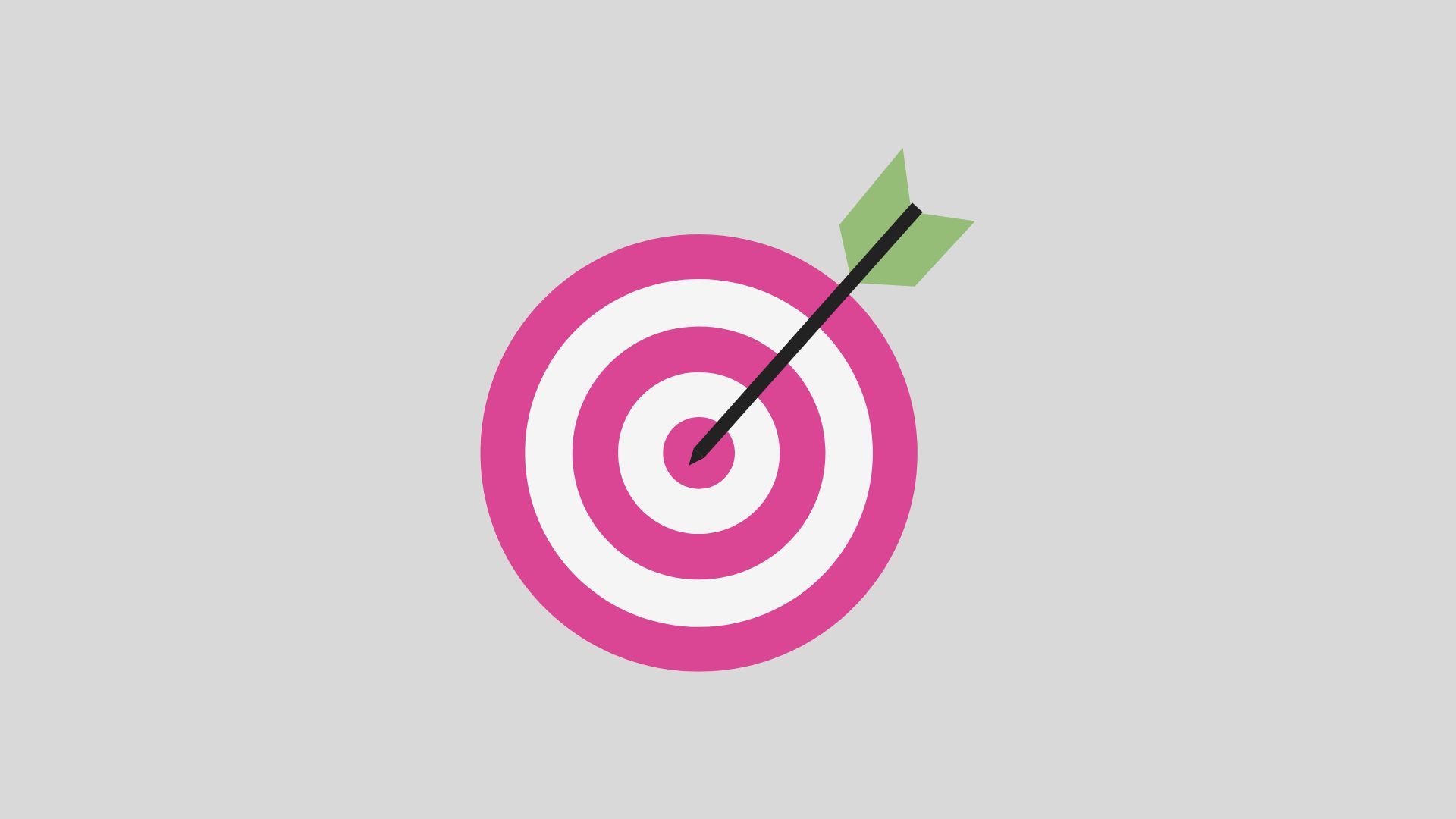
Buyer persona examples for a real estate business:
- Buyer Persona Example 1: First time home buyer Frank
- Buyer Persona Example 2: Vacation home buyer Victor
- Buyer Persona Example 3: Apartment renter Raquelle
- Buyer Persona Example 4: Home seller Henry
- Buyer Persona Example 5: House flipper Florence
- Buyer Persona Example 6: Real estate investor Isabella
There are different types of real estate buyers. In this buyers persona example, we have identified six. For this example real estate business, it is best to focus on first time home buyers because they can fullfill their needs, and alleviate their concerns in the best way. We have also given the buyer persona a memorable name.
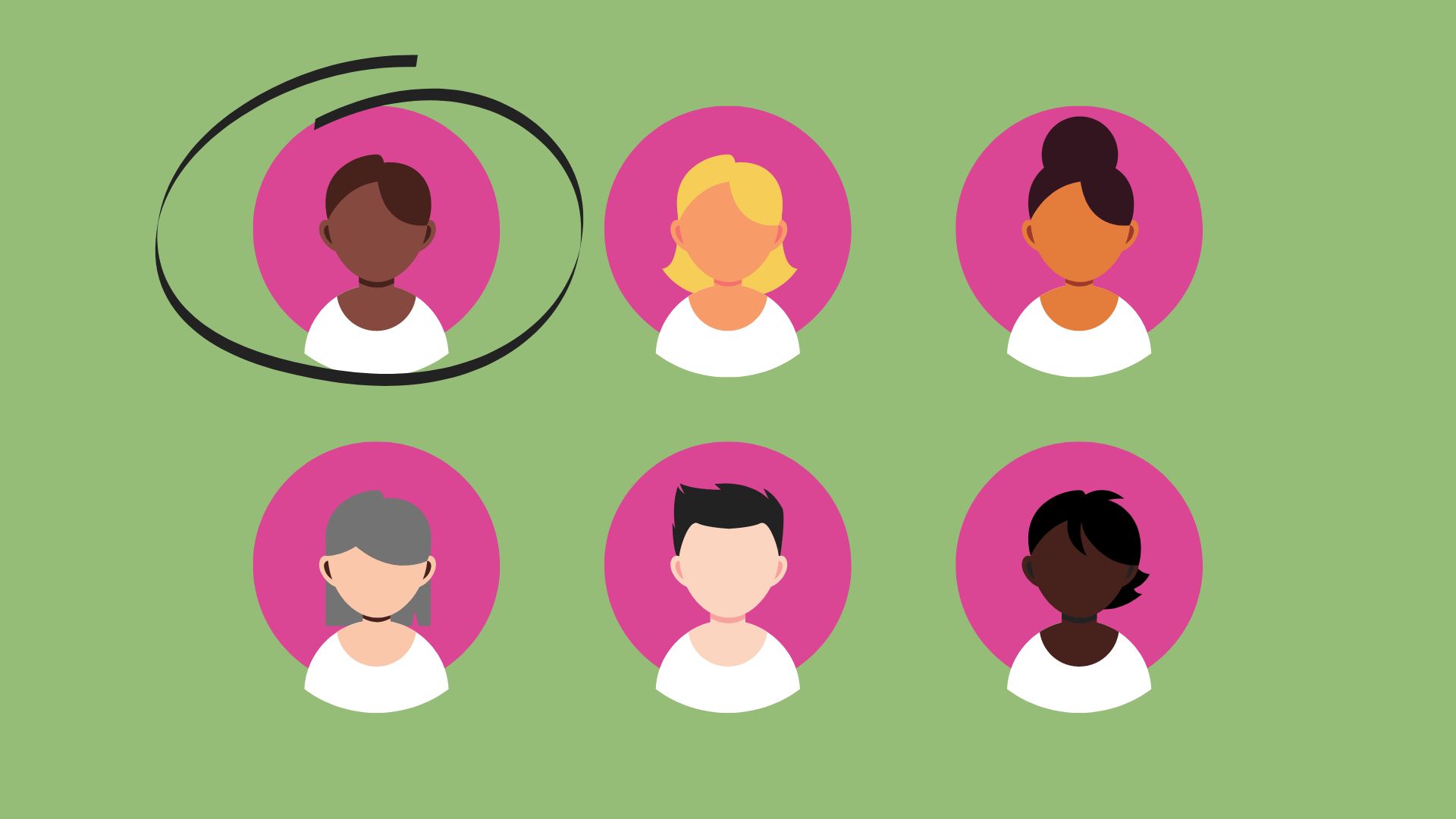
Buyer persona examples for a travel business:
- Buyer Persona Example 1: Couple vacation Chris & Charlotte
- Buyer Persona Example 2: Weekend break Wendy
- Buyer Persona Example 3: Gap year Gabriele
- Buyer Persona Example 4: Package holiday Patrick
- Buyer Persona Example 5: Business travel Bill
- Buyer Persona Example 6: Language learning Lacy
There are different types of travelers with different needs and wants. In these examples of marketing personas, we have identified six types of travelers. For this example travel business, it is best to focus on couples who want to go on a couple vacation. This is the audience the business has identified for themselves they can help them the most and have the best offers for them.
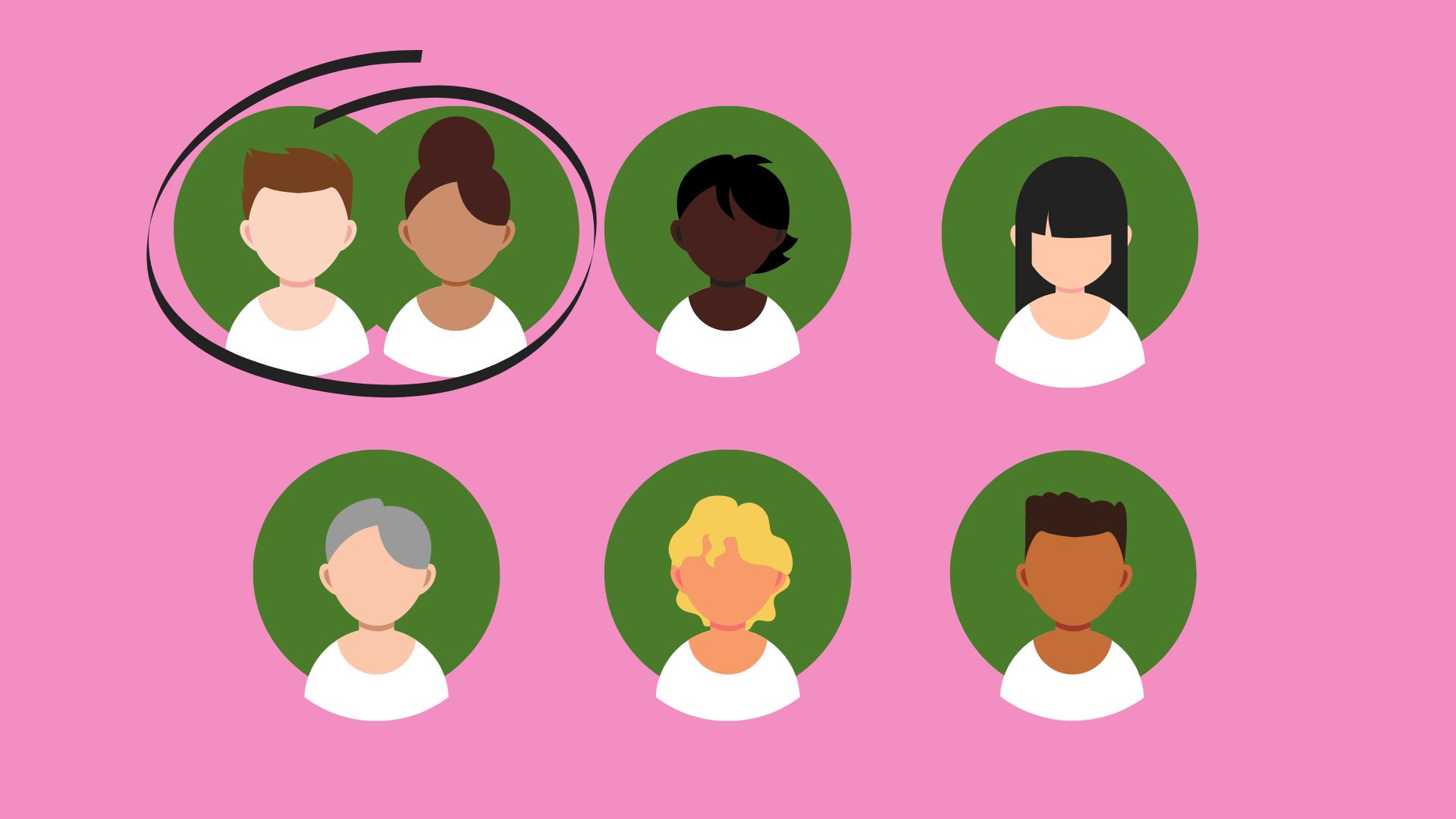
How To Write A Buyer Persona STEP 2:
In the next step, you can get a bit more precise and describe the main characteristics, goals, wants and needs of your buyer personas. Look at the following target market persona example for a gardening business.
Buyer persona example for a gardening business:
- Decorative Plant Lover Debbie:
- Female, Age 23-33
- Lives in a city
- Wants her city apartment to look more stylish
- Is primarily interested in indoor plants for decoration
- Is busy and needs plants that are easy to care for
- Occasionally wants fresh herbs to cook with
In this buyer persona example, our example gradening business has decided to go with 'decorative plant lover Debbie' as their primary buyer persona. They came up with the main characteristics about Debbie like her gender, age, where she lives and the lifestyle she has. They came up with what Debbie wants and what fits in her lifestyle, as well as what she doesn't want. As a busy city girl, she'll have objections against plants that require a lot of intensive care and attention. Recommending her beautiful looking plants that are easy to care for is the way to go to serve and please this example of customer persona. While there are different types of buyer personas, this simple buyer persona style is very commonly used. However, we're only at step 2 of how to write a buyer persona and this is not quite detailed enough yet to see the success you derserve from using buyer personas. Let's further refine it and look at more audience persona examples in the following steps.
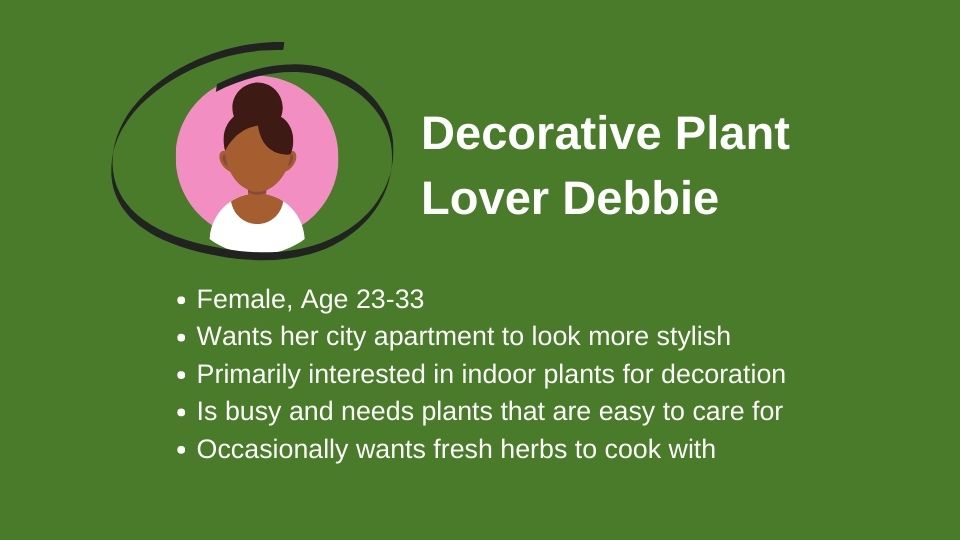
How To Write A Buyer Persona STEP 3:
In the next step, you get even more detailed and start adding buyer persona profile features to your buyer personas. Have a look at the following buyer persona example for a business in the health and fitness industry – a gym.
Buyer persona example for a gym:
- Health-conscious Heather:
- Gender: Female
- Age: 25-40
- Family: Not specified
- Relationship status: 20% single, 5% engaged, 55% in a relationship, 25% married
- Level of education: 43% college, 15% grad school, 42% highschool
- Social networks: Uses facebook to keep up with friends and family, uses YouTube for entertainment, uses Instagram for inspiration, uses LinkedIn to receive updates from favorite businesses and brands
- Profession: Working class
- Industry: Not specified
- Income: $30,000/year
- Interests: Health, fitness, spirituality, relaxation
- Pain points: Work life balance, craves fast food
- Goals: Having no health issues in old age, staying fit and healthy, feeling young and looking youthful, escaping, feeling fit and happy in their dream body
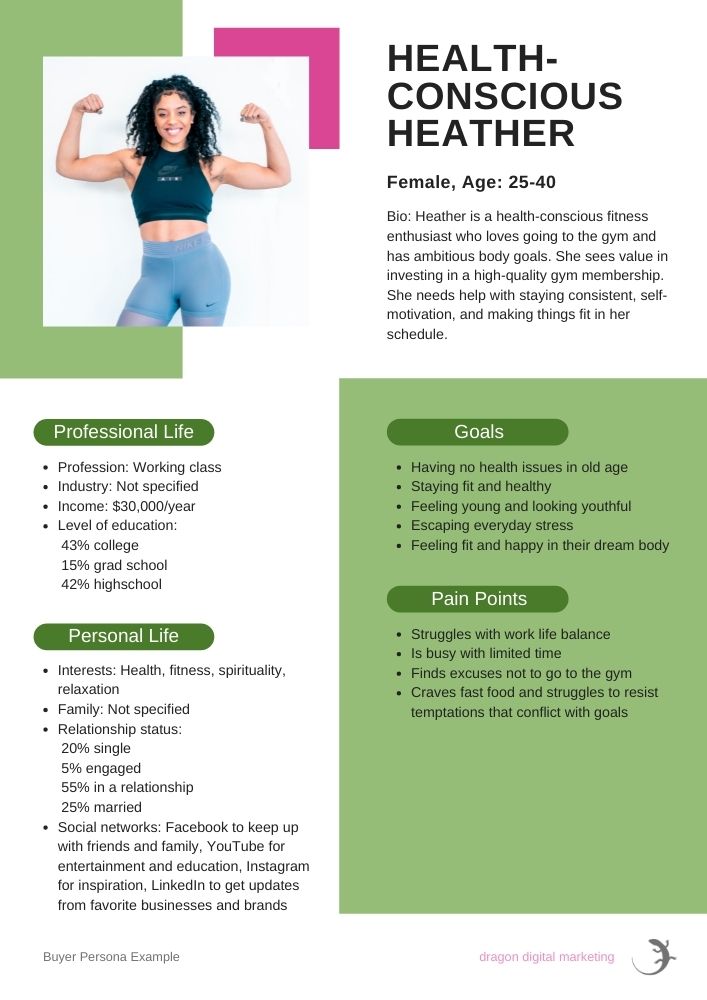
This is the step where it's time to become a detective and analyze your audience data. Our example gym has analyzed their website visitors and social media audiences and found some more detailed information about their ideal customer 'health-conscious Heather'. Then they had a look at what income women in Heather's demographic have and added some more info about her professional life. Our example gym used more public information that people share about themselves online like their education and relationship status to further build their buyer persona.
After a quite while, our example gym has captures a significant amount of the 'health-conscious Heather' audience segment. They're do really well and see a lot of engagement online as well as signups for new memberships from that segment. So, they've decided to expand and build out a second buyer persona. In this example of buyer persona, we've called him 'Ladies' man Larry'.
- Ladies' man Larry
- Gender: Male
- Age: 15-35+
- Family: Not specified
- Relationship status: 50% single, 7% engaged, 38% in a relationship, 5% married
- Level of education: 35% college, 10% grad school, 55% highschool
- Social networks: Uses Facebook to keep up with friends and family, uses YouTube for education, uses Instagram for entertainment, uses LinkedIn for professional networking, uses dating apps
- Profession: Not specified
- Industry: Not specified
- Income: $43,000/year
- Interests: Building muscle, looking chiseled, relaxation
- Pain points: Shedding fat, alcohol and meat consumption, tobacco use
- Goals: Appealing to women, feeling strong and fabulous in their dream body
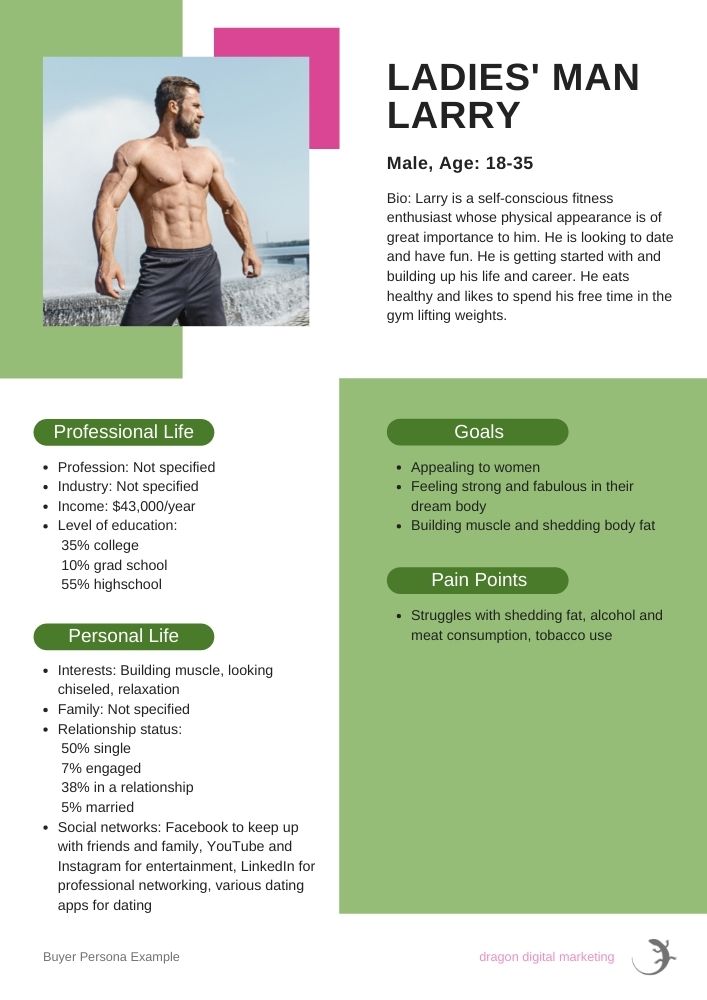
How To Write A Buyer Persona STEP 4:
A buyer persona isn't something you create once and then forget about. It a living document that needs consistent updating to stay relevant. Your audience needs and wants change over time as circumstances in the environment change. Successful businesses stay agile and adapt quickly by staying up-to-date with their buyer personas. You'll find that over time you gain so much more information about your buyers and their behavior and beliefs. You can add this to your buyer personas and make it more detailed. Here are some buyer persona questions to ask to gather more customer insights. The more you know, the better. Being able to have all this information at your disposal is very powerful for your marketing.
To give you some inspiration of how it looks like when you dig deep and go all the way down to the nitty gritty, here are some marketing persona examples how a professional, award-winning digital marketing agency creates them.
Buyer Persona Examples From The Dragon Digital Marketing Agency
➤ Buyer Persona Example 1 by Dragon Digital Marketing (PDF)➤ Buyer Persona Example 2 by Dragon Digital Marketing (PDF)
84 Buyer Persona Questions
Here are 84 buyer persona interview question ideas. They are B2C and B2B buyer persona questions to ask in interviews with customers and when creating buyer personas. These buyer persona questions will inspire your buyer persona research and help you profile your customer. The buyer persona questions will get you started when developing your buyer persona profiles. Be sure to ask them while creating your ideal buyer personas for your small business.
B2C and B2B buyer persona questions about the personal background and daily life:
- What is your gender?
- What is your age?
- What is your marital status?
- Where do you live? Where are you located?
- Are you a homeowner or renter?
- What is your income?
- Do you have children? How many? What ages?
- What level of education do you have? Which schools did you go to? What did you study/major in?
- What does a typical day look like for you?
- How much time do you spend at work and at home?
- What do you do for fun?
- Who are the people in your life that are most important to you?
- What types of vehicles do you own? What car do you drive?
- What do you like to watch on TV / YouTube / Netflix?
- What type of indulgent or luxurious purchases do you make?
- What accomplishments are you most proud of?
- What are the top three things on your bucket list?
- What initially attracted you to us / me?
B2C and B2B buyer persona questions about challenge, fears and pain points:
- What are your biggest challenges with _____?
- What do you feel is inconvenient about ___?
- What are you not content with about ___?
- What is the most frustrating part of your day?
- What is the worst customer service experience you've ever had?
- What regular activity do you find stressful?
- What makes you feel nervous?
- What is the fastest way for somebody to make you angry?
- What is your least favorite part of ___?
- What do you worry about?
- What would prompt you to seek a solution for ___?
- What would happen if they picked the wrong solution?
- What would happen if they did nothing at all?
B2C and B2B buyer persona questions about the goals:
- What personal goals do you have?
- What career goals do you have?
- What are you responsible for?
- What does it mean to be successful for you?
B2C and B2B buyer persona questions about preferences:
- How do you search for information? What websites do you use to do research and learn more?
- Describe a recent purchase related to ___.
- Why did you consider your last few purchases related to ___?
- What is the evaluation process like when looking to buy ___?
- How did you decide to purchase ___?
- What is your favorite communication technology? Do you prefer talking to someone on the phone, or communicating over emails, or using a project management system like Slack, or using chats, or text messages?
- How do you prefer to do your shopping?
- Who do you ask for product/service recommendations?
- How important is it to get a good deal?
B2C and B2B buyer persona questions about improvements and constructive criticism:
- What 3 words would you use to describe us?
- What 3 words would you use to describe the other companies you were evaluating?
- What was your biggest concern or reservation about buying from us?
- Why did you choose us over another company?
- (If not a customer) Why did you choose Company X over us?
- What could make us even better? In the buying process and afterwards.
- What could we do to reach more people just like you?
B2B buyer persona questions about the job, role, profession:
- What is your role?
- What is your title?
- How long have you been in your current position? How many years of experience do you have in what you do?
- Describe your career path. How did you end up where you are today?
- How is success measured in your job? What does it mean to be successful in your role?
- To what job level do you aspire?
- What does a typical work day look like for you?
- What are you responsible for?
- What skills are required to do your work?
- What knowledge and softwares or tools do you use?
- Who is your boss and what is the relationship like?
- Who do you report to?
- Who reports to you?
- How do you learn about new information?
- What publications or blogs do you read to educate yourself to become better at your job and learn?
- What associations do you participate in?
- What social networks are you active on?
- What is your least favorite part of your job?
- What is the worst job you can imagine?
B2B buyer persona questions about the company:
- In which industry or industries does your company operate?
- What is the size of your company in terms of revenue and the number of employees?
- What are the company's business goals?
- What are the most common challenges related to your industry?
- What value is typically associated with your industry?
- What is the preferred type of sales experience in your industry?
- What are the most common objections to your product or service?
- What are the top questions asked by customers?
- What are the top questions asked by prospects?
Pro tip #1:
Ask a Why-Question after they give you an answer to ncover more information.
Keep in mind that people aren't always great at reflecting on their behaviors to tell you what drives them at their core. Asking a why-question helps you to better understand goals, behaviors, and motivators.
For example:
Q: "What is your biggest challenge with ___?"
A: ___
Q: "Why do you think that is?"
A: ___
Pro tip #2:
Ask yourself some negative buyer persona questions. Think about what customers you don't want and who you want to exclude from your target audience.
negative buyer persona B2C and B2B buyer persona questions:
- What makes a customer difficult for your small business?
- What types of customers are too expensive to support?
- What types of potential customers don't have the right budget for what you offer?
- What are the least lucrative industries with the lowest profit margins for your business?
- Is your product or service a bad fit for some people and not designed for them?
How To Write A Buyer Persona & Where To Begin The Buyer Persona Research
Here's how you start with creating buyer personas for your small business.
Think about the problem that your business solves and the challenges you help your customers to overcome. Then start with thinking about your existing customers and what you know about them and how you help them.
The 2 most common mistakes to avoid when creating buyer personas:
#1: You want your buyer personas to be realistic and not just guess random things. You'd run into the risk of guessing things about your customers that are wrong and they have entirely different frustrations, wishes and priorities. Using far-fetched, made up buyer personas is just as bad as using no buyer personas for your small business marketing.
#2: On the other hand, you don't want your buyer personas to be too real. You don't want to base them on only a few customers you've had and make them way too specific, so you cannot draw any general conclusions. Your ideal customer avatars should represent your whole target audience, not just a few cherry picked individuals.
Think about it. This is the buyer persona definition: A buyer persona is a semi-fictional representation of your ideal customers.
Some of it is fictional and some of it is real. The best way to do buyer persona research and collect the information you need is by doing surveys and/or interviews with your ideal buyers.
Of course you can make educated guesses, too. The keyword here is educated. Your guesses and assumptions have to be based on data and insights you already have and know is sound, valid and reliable.
Who Should Be Involved In Creating Your Buyer Personas?
A buyer persona is a marketing tool. Therefore your marketing team should be involved in creating your buyer personas. Afterall, marketing likely has the most data about prospects and customers. Sales and customer service gets a lot of insight, too.
Ideally, every customer-facing member of your team should be involved and contribute to your buyer personas. This includes you as the small business owner and your executive leadership, too. You know your company's goals and vision and thus should contribute.
In a nutshell: Anybody who interacts with your customers, directly or indirectly, should be invited to give input.
What Information Do I Have To Include In My Buyer Persona Profile?
You won't be able to create an accurate and detailed buyer persona overnight. Start with some basic information and work your way up to the nitty gritty step-by-step.
Here is a list of example buyer persona characteristics:
- Name
- Gender, if any
- Age range and percentages of age distribution
- Family
- Relationship status
- Level of education
- Social networks they use and why
- Job, position, profession
- Industry
- Income, Revenue, Profit
- Hobbies and interests
- Pain points
- Goals
- Vision
- Mission
You also want to ask some more buyer persona questions to get more qualitative information about your ideal customers and target audience.
Pro tip on how to write a buyer persona:
And a great tip to personify and humanize your buyer persona is to give him or her a name and select buyer persona images.
A buyer persona image is the profile picture of your buyer persona profile. It can be an illustrated avatar or a stock photo of a real person who looks like your persona.
We see so much data and so many numbers of likes, followers, comments, subscribers, unsubscribers, page views, checkout completions, etc. that it's easy to forget that those are real people. Naming your persona like a human being and putting a face to their name helps to humanize them.
How Do I Choose My Ideal Client Or Perfect Buyer Persona? What Things Do I Need To Look Out For When Doing Buyer Persona Research?
It all starts with market research.
You know what you want to do in your business, who you want to serve, what kind of service you provide or product you sell. You are in a particular industry and that industry has subcategories - smaller niches within the overall market. You want to position yourself in one of those niches.
Your brand positioning can't be broad because you're just not going to be able to be heard through the noise. There are the big companies out there with their million and billion dollar marketing budgets and also a lot of small businesses that are competing for a market share in your market. It's a crowded marketplace.
You have to pick a niche that is a small sub segment in the market and be super specific. In that niche you'll find a specific type of person, a specific persona, and that is who you want to market to and attract. It's about finding a group of people who have a lot in common and you can tailor your marketing to with the resources you have as a small business to be successful. You can always expand later and try talking to a different group of people who can use your service or product.
The narrow group of people you have identified have a lot of different points in common that connect them. You want to identify those points by asking questions. This is the goal of your buyer persona research. When you do your buyer persona research, ask questions and actually listen actively to the answers.
Active listening is really about understanding the other person and not just listening to reply. You can't have a fixed idea in your head about a product or service to sell to every client, without listening to their individual needs, wishes, desires, objections and pain points. There is not a one size fits all approach to effective marketing. You can't have that cookie cutter approach when you want your digital marketing campaigns to be successful. You need to tailor everything.
How Can I Collect The Information I Need To Write A Buyer Persona?
There are a number of buyer persona research methods:
- Do some Google research
- Read industry reports
- Use marketing analytics tools
- Leverage the Facebook Audience Insights tools
- Analyze your social media following and their engagement, interests and activity
- Look at your competitors (position yourself uniquely if possible and don't try to attract the same buyers)
- Create surveys
- Take a look into your CRM (Contact relationship management system)
- Conduct interviews
You'll get to the point where you can no longer do the buyer persona research by yourself and need to have a conversation with your ideal customers.
You can create a survey and send out the link to your existing customers and ideal prospects in your audience. Surveys are great because you collect all of the responses and then you have them all in one place. There are a lot of online survey tools and they give you reports and can even visualize the data for you. Graphs and charts help you to work with the data and see distributions and ratios and correlations.
The thing is that the response rate of surveys tends to be low. A lot of people just ignore them. They simply don't feel like filling out a survey.
The best thing you can do is reach out one-on-one and use a personalized message. Don't use bulk messaging software. You reach out via email, connect on LinkedIn or other social media platforms, or pick up the phone and give your ideal clients a call.
I recommend the old fashioned way of just picking up the phone. In general, you should follow up with your customers on a regular basis and see how things are going for them and check in to nurture the relationship.
It's best to just ask your existing customers, call them up and have a conversation like a normal person who cares. Typically people are flattered if you ask them for their opinion and care to hear about their feedback to something or get an update. It feels nice when you matter to someone.
Pro tip to get more people to say yes:
You'll get a lot more people to say yes if you make it clear in the beginning that you don't have any hidden agenda and won't be pushy. Right off the bat, make it very clear that you are not trying to sell them anything and are simply asking their opinion.
If you want to optimize your product or service, ask your customers what you can improve and how happy they are. Ask them about their vision and mission and what goals they want to achieve. Ask them about their dreams, hopes, wishes, fears, desires, frustrations, hobbies, income, favorite foods, favorite places to shop, etc. If you're in B2B, ask them about their strategy, technologies they use, role and responsibilities, buying center, report line, budget, etc.
Why Do I Have To Niche Down To Write A Buyer Persona? Doesn’t This Mean I'm Missing Out?
You want to listen to your customers and make sure that you understand what they want and need before you recommend anything to them. Just like a doctor cannot prescribe something without making a diagnosis first.
In your case, your diagnosis is to get to know your audience in a more detailed way than just the surface. It's not enough to know just the age range and demographics. You really want to dig deep, so your messaging, your marketing, and all of your communication feels like a one-on-one conversation.
You want to tailor your social media posts and email marketing campaigns so they resonate with the people you want to reach. That's exactly what you achieve by having detailed buyer personas.
Don't be afraid to niche down because of FOMO (fear of missing out). You are not missing out on opportunities by niching your small business marketing strategy down because when you try to speak to everybody you speak to nobody.
I can totally relate to that thought. I think it's completely normal. We want to serve the maximum amount of people out there with our business and make the most amount of money to achieve the level of success we desire. And to grow and scale our small businesses and impact more people's lives and help more people out.
Here's the thing:
It's such a crowded place out there nowadays. On the internet, you're competing with people from across the globe, people in other countries and other continents. If you're not niching it down and you're trying to talk to too many people, what happens is that you end up talking to nobody because it's not specific enough. If you just have those general phrases and messages, it won't resonate enough with people for them to stop scrolling and pay you attention.
People are bombarded with marketing messages 24/7/365. The way you stand out is by making it super personalized and targeted to the point where your marketing doesn't even feel like marketing anymore. It really feels like a conversation with a friend or a family member that really knows you because they tailor their messaging to you.
When you get a message from her friend, you wouldn't even waste a second asking yourself if they sent that same message to 500 other people, right? You know they just sent it to you because it has context of your past interactions, conversations, activities and experiences that you do not share with a lot of other people. You want to achieve the very same thing in your business and make your digital marketing as personal and as human as you possibly can. And that's why you gather all of that information about your ideal customers and have to create buyer personas.
Isn’t It Unprofessional To Get Personal?
No, it's not. No matter whether you're in B2B (business to business) or B2C (business to consumer), everybody is in P2P (people to people).
People buy from people. We deal with people. We communicate with people. If we find a person sympathetic, we can empathize with them. That makes a world of a difference in our communication.
If you want to truly resonate on a deeper level with your ideal clients, you need to get personal and it's not unprofessional at all. The opposite is true. It helps you to connect better. Tap into this potential.
You want to dive deep into their culture, what foods they like, what their lifestyle looks like, their demeanor, hobbies, education, relationship status, interests, identifiers, etc.
For example:
If you find out that the people connected to your Facebook Business Page are 17x more likely to like Oreos, than the average facebook user, you can pick this up in your marketing messaging.
People are loyal to the brands they love and can identify with brand messages. Reese's vs Snickers or Dunkin' vs Starbucks can make a big difference. The same goes for clothing brands and all other things they like. It reveals more about their personality. Each brand has a brand personality that is meant to attract people who have the same personality.
You'll see better email open rates, more engagement on your social media posts, more video views, an increase in website traffic and other content if you utilize this information in a savvy way. This information can serve as a hook to get attention you otherwise wouldn't have gotten and helps you to build rapport instantly.
How Many Responses From Existing Customers Do I Need For A Meaningful Buyer Persona?
It depends on the size of your target audience. You want your buyer personas to be significant, sound and informative and represent each of your audience segments properly.
You don't need hundreds and hundreds of responses. You'll start to see patterns and answers repeating after about 5 conversations.
If you have a large target market with several millions of people, I think 50 responses are great. More than that is mostly not necessary, not even for large audiences.
In my own experience:
5-50 responses are a good guideline depending on your small business. Interviewing less than 5 people for your buyer personas is oftentimes not significant enough.
What For And How Am I Going To Use The Information About My Buyer Persona In My Small Business?
You'll reference your buyer personas all the time over and over again. They will help you in all of your small business marketing and communication efforts.
Buyer personas help you to:
- Create a digital marketing strategy
- Execute your digital marketing plan
- Start a conversation with prospects at an event
- Engage in small talk
- Build rapport instantly
- Write effective sales copy for your landing pages and sales pages
- Write higher-performing marketing emails
- Create engaging social media posts
- Get more effective ads
- Come up with new content to curate, publish and promote
- Film resonating videos
- Make convincing argumentations in sales conversations
- Reach higher website conversion rates
A buyer persona is an essential puzzle piece in any business. It's like when you drop a pebble in a pond and it starts to ripple out. Personas are pretty big foundational pieces and keeping them current and updated ensures that you actually understand what your customers need and want.
The information in buyer personas is important for your entire business and you may want to share it with all of your "departments". Being able to help your customers out in a better way is what brings you success and allows you to grow and scale your small business.
👉 Buyer personas are the key to small business success.
– Monique Idemudia
How To Find Interviewees For Researching Buyer Personas: 4 Tips For Recruiting Buyer Persona Interviewees
- Check your Customer Relationship Management System (CRM) for customers and think about who stands out to you when you think about past customer interactions.
- Have a look at your past email conversation with customers.
- Ask your sales team about experiences with customers that they recommend to interview
- Go through your following on social media and see who is engaged and likely to say yes to an interview
Important: Do not ask anybody you already know and who is a friend or relative. They will not be as raw and honest with you as a stranger. You don't want to falsify your buyer persona research with sugar-coated answers or lies - as well-intentioned as they may be, they do not serve you.
Buyer Persona Template [Free Download]
No need to reinvent the wheel and start from scratch. Download our buyer persona template PDF that serves as a buyer persona worksheet.
You can use our customizable B2C and B2B buyer persona template to create your own buyer personas.
Download the free buyer persona template!
Buyer Persona Videos
Buyer Persona Development
Get your buyer personas done for you and hire our agency for your buyer persona research and creation.
Our digital marketing agency will create buyer personas for your small business.
Get your buyer personas done for you!
Conclusion
Buyer personas are semi-fictional representations of your ideal customers based on market research and real data about your existing customers. They allow you to group your audience into different segments. You can then create more targeted content for each of those groups and get more effective marketing campaigns and stronger results.
To create effective buyer personas, you have to ask yourself and your audience some questions and get into details about where they stand, what they want and need, and where they want to be.
You can create your own buyer personas with a buyer persona template or hire a small business digital marketing agency to create buyer personas for your small business.
Try ActiveCampaign - The #1 Automation Platform For Small Businesses
It gives you the email marketing, marketing automation, and CRM tools you need to create incredible customer experiences.
 Try
ActiveCampaign Today For Free
Try
ActiveCampaign Today For Free
Free Buyer Persona Template
Easily organize your audience segments and make your marketing stronger. Free Download.
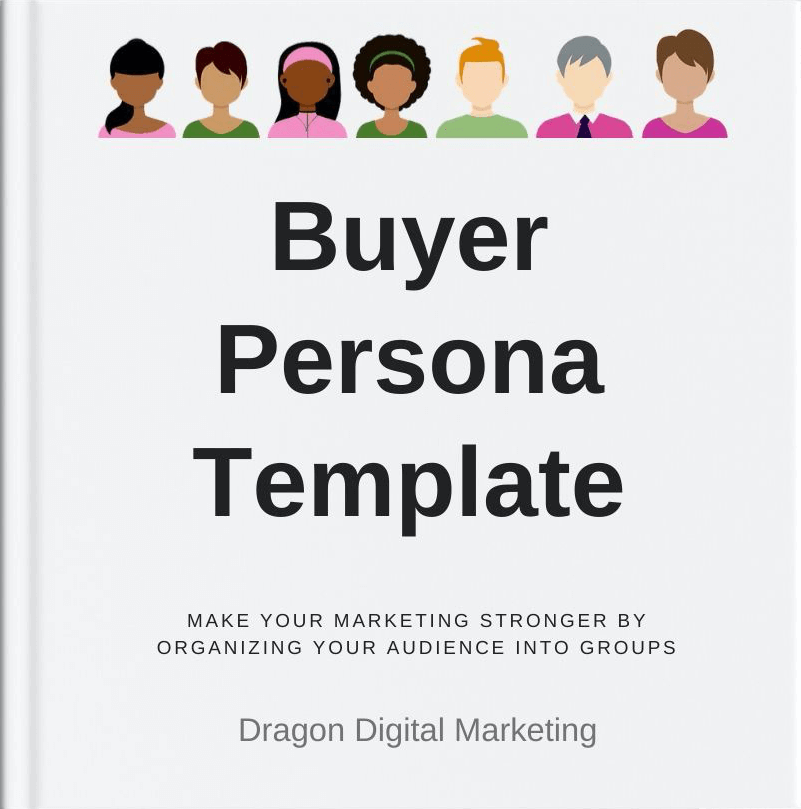
Get A Free
Buyer Persona Template


